System Analysis Report: Vendor Solutions and SDLC for My Health Record
VerifiedAdded on 2023/06/11
|8
|1680
|485
Report
AI Summary
This report presents a system analysis of the 'My Health Record' project, focusing on identifying suitable vendor solutions and the appropriate Software Development Life Cycle (SDLC) approach. It evaluates three top vendor solutions: Microsoft, Amazon Web Services (AWS), and Salesforce.com, highlighting their features and advantages in providing cloud services such as IaaS, PaaS, and SaaS. The report also reviews the advantages and disadvantages of cloud-based systems, including cost-effectiveness, accessibility, and security concerns. Furthermore, it discusses the pros and cons of predictive and adaptive SDLC models, recommending a predictive approach for the 'My Health Record' system due to its clear objective definition and risk minimization. This analysis aims to provide insights into optimizing the efficiency and security of the 'My Health Record' system within the Australian healthcare landscape. Desklib offers a wealth of similar solved assignments and study resources for students.
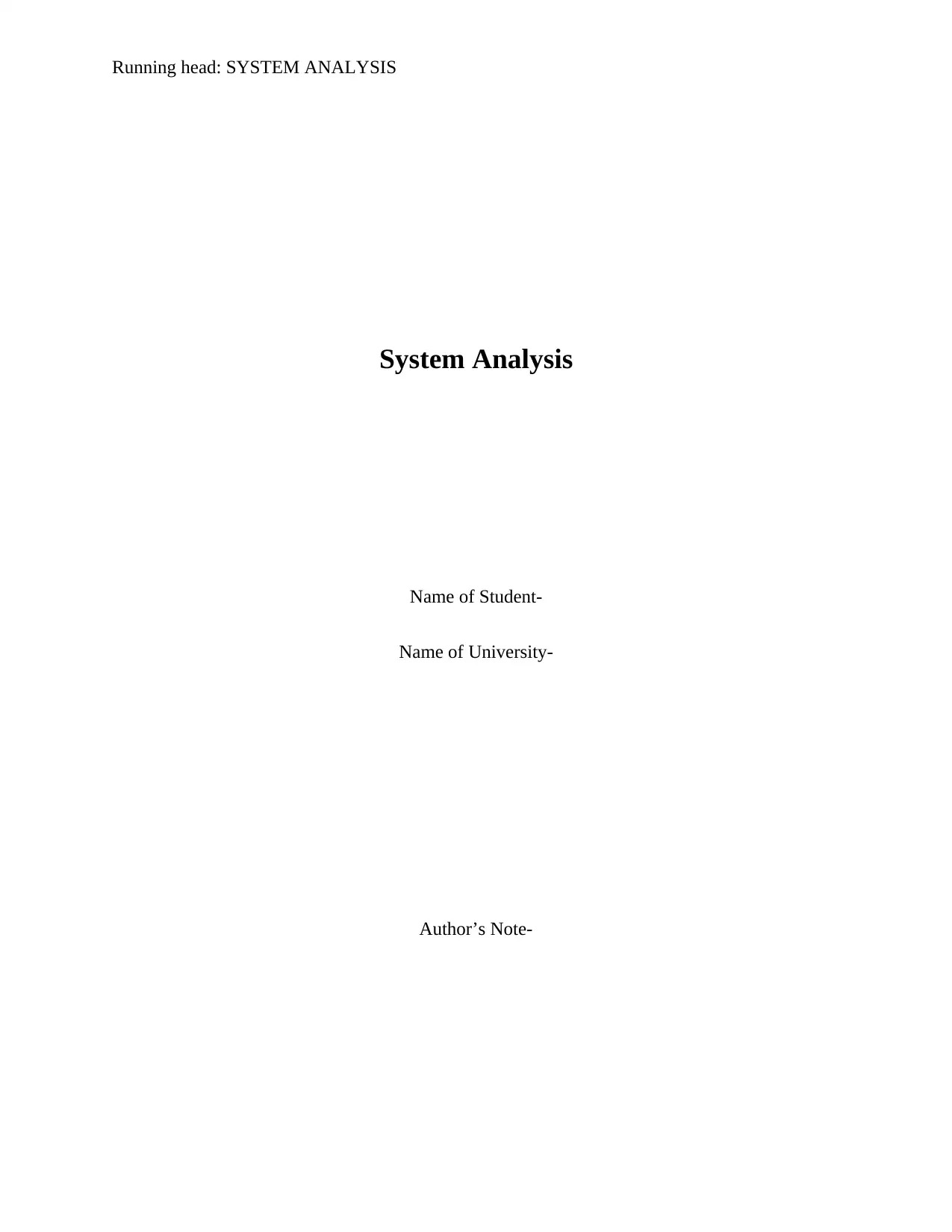
Running head: SYSTEM ANALYSIS
System Analysis
Name of Student-
Name of University-
Author’s Note-
System Analysis
Name of Student-
Name of University-
Author’s Note-
Paraphrase This Document
Need a fresh take? Get an instant paraphrase of this document with our AI Paraphraser
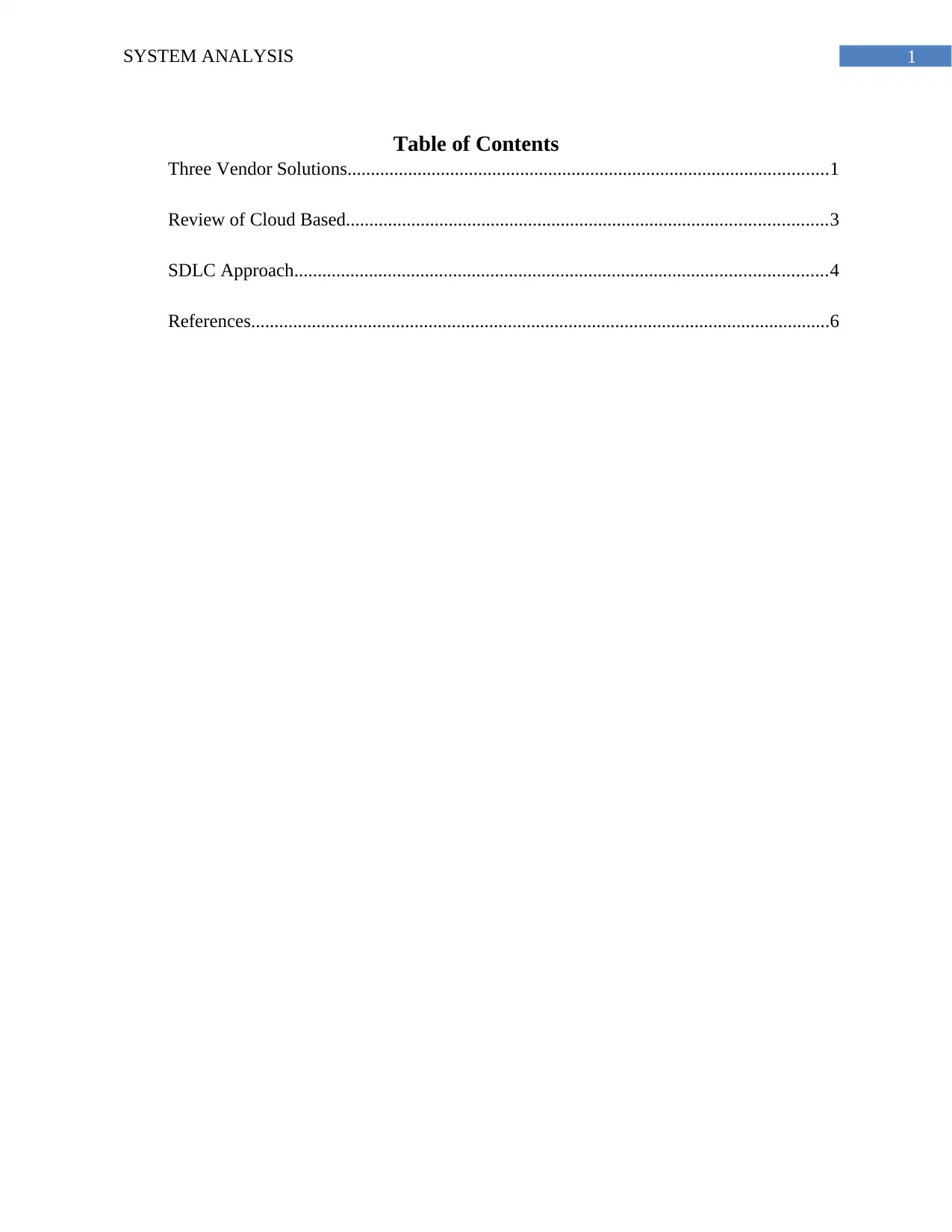
1SYSTEM ANALYSIS
Table of Contents
Three Vendor Solutions.......................................................................................................1
Review of Cloud Based.......................................................................................................3
SDLC Approach..................................................................................................................4
References............................................................................................................................6
Table of Contents
Three Vendor Solutions.......................................................................................................1
Review of Cloud Based.......................................................................................................3
SDLC Approach..................................................................................................................4
References............................................................................................................................6
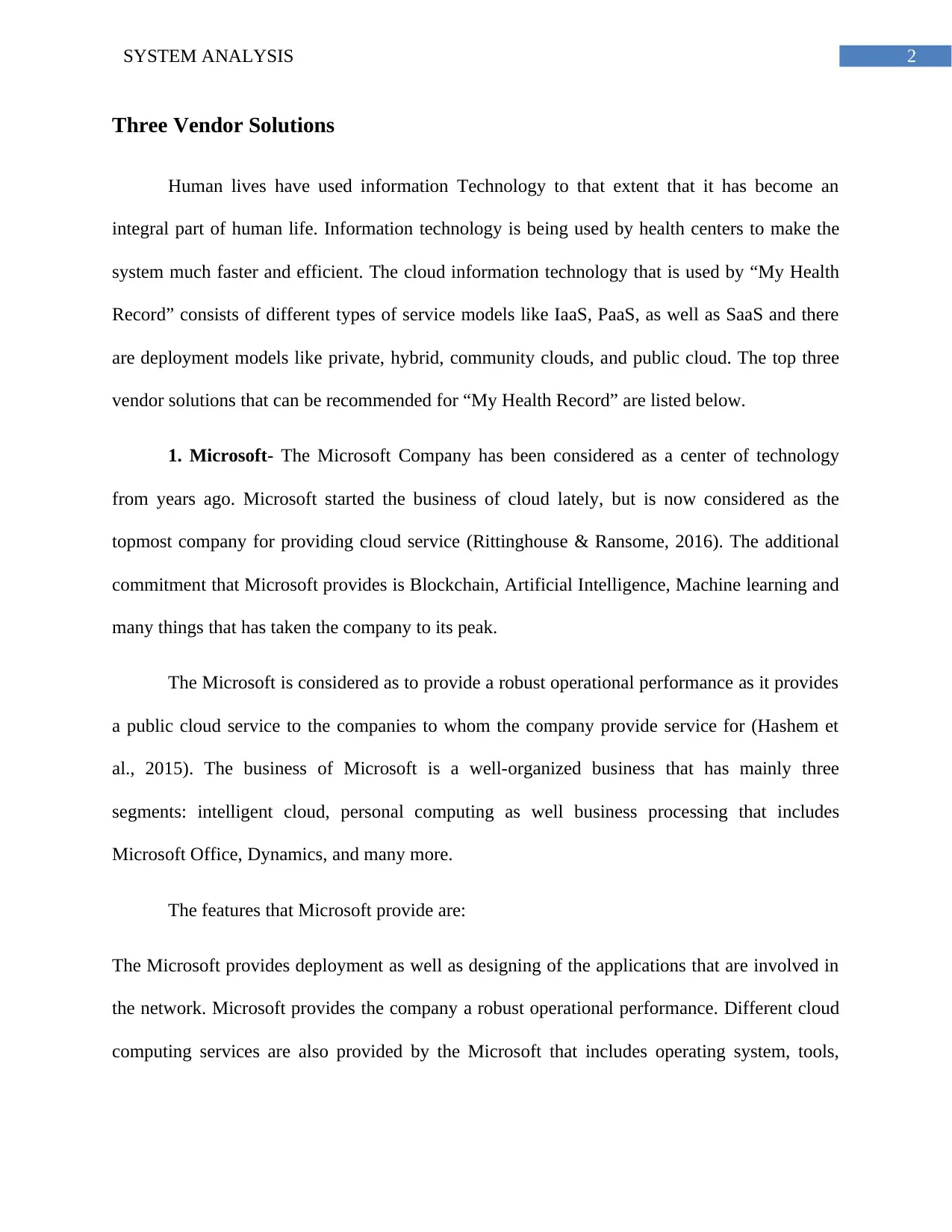
2SYSTEM ANALYSIS
Three Vendor Solutions
Human lives have used information Technology to that extent that it has become an
integral part of human life. Information technology is being used by health centers to make the
system much faster and efficient. The cloud information technology that is used by “My Health
Record” consists of different types of service models like IaaS, PaaS, as well as SaaS and there
are deployment models like private, hybrid, community clouds, and public cloud. The top three
vendor solutions that can be recommended for “My Health Record” are listed below.
1. Microsoft- The Microsoft Company has been considered as a center of technology
from years ago. Microsoft started the business of cloud lately, but is now considered as the
topmost company for providing cloud service (Rittinghouse & Ransome, 2016). The additional
commitment that Microsoft provides is Blockchain, Artificial Intelligence, Machine learning and
many things that has taken the company to its peak.
The Microsoft is considered as to provide a robust operational performance as it provides
a public cloud service to the companies to whom the company provide service for (Hashem et
al., 2015). The business of Microsoft is a well-organized business that has mainly three
segments: intelligent cloud, personal computing as well business processing that includes
Microsoft Office, Dynamics, and many more.
The features that Microsoft provide are:
The Microsoft provides deployment as well as designing of the applications that are involved in
the network. Microsoft provides the company a robust operational performance. Different cloud
computing services are also provided by the Microsoft that includes operating system, tools,
Three Vendor Solutions
Human lives have used information Technology to that extent that it has become an
integral part of human life. Information technology is being used by health centers to make the
system much faster and efficient. The cloud information technology that is used by “My Health
Record” consists of different types of service models like IaaS, PaaS, as well as SaaS and there
are deployment models like private, hybrid, community clouds, and public cloud. The top three
vendor solutions that can be recommended for “My Health Record” are listed below.
1. Microsoft- The Microsoft Company has been considered as a center of technology
from years ago. Microsoft started the business of cloud lately, but is now considered as the
topmost company for providing cloud service (Rittinghouse & Ransome, 2016). The additional
commitment that Microsoft provides is Blockchain, Artificial Intelligence, Machine learning and
many things that has taken the company to its peak.
The Microsoft is considered as to provide a robust operational performance as it provides
a public cloud service to the companies to whom the company provide service for (Hashem et
al., 2015). The business of Microsoft is a well-organized business that has mainly three
segments: intelligent cloud, personal computing as well business processing that includes
Microsoft Office, Dynamics, and many more.
The features that Microsoft provide are:
The Microsoft provides deployment as well as designing of the applications that are involved in
the network. Microsoft provides the company a robust operational performance. Different cloud
computing services are also provided by the Microsoft that includes operating system, tools,
⊘ This is a preview!⊘
Do you want full access?
Subscribe today to unlock all pages.

Trusted by 1+ million students worldwide
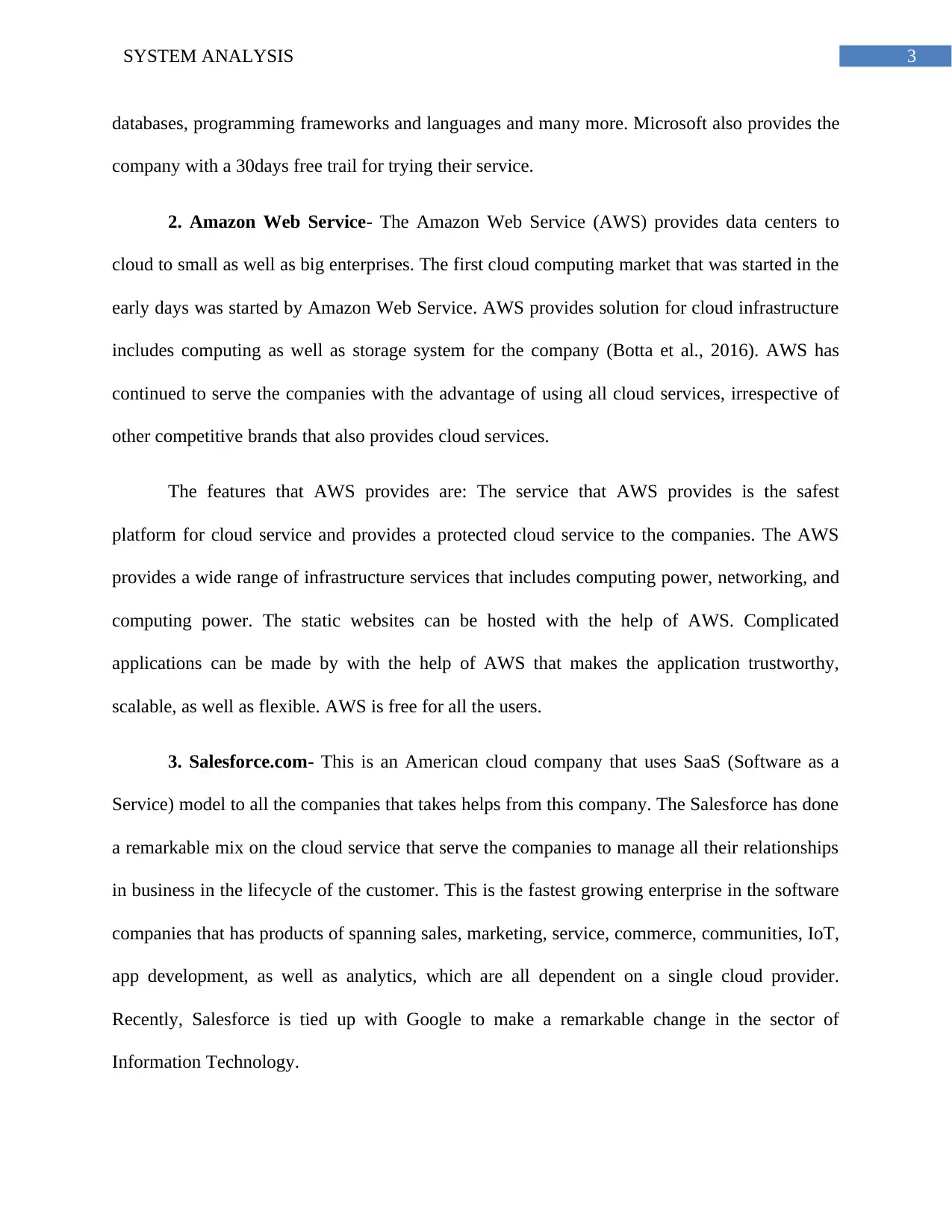
3SYSTEM ANALYSIS
databases, programming frameworks and languages and many more. Microsoft also provides the
company with a 30days free trail for trying their service.
2. Amazon Web Service- The Amazon Web Service (AWS) provides data centers to
cloud to small as well as big enterprises. The first cloud computing market that was started in the
early days was started by Amazon Web Service. AWS provides solution for cloud infrastructure
includes computing as well as storage system for the company (Botta et al., 2016). AWS has
continued to serve the companies with the advantage of using all cloud services, irrespective of
other competitive brands that also provides cloud services.
The features that AWS provides are: The service that AWS provides is the safest
platform for cloud service and provides a protected cloud service to the companies. The AWS
provides a wide range of infrastructure services that includes computing power, networking, and
computing power. The static websites can be hosted with the help of AWS. Complicated
applications can be made by with the help of AWS that makes the application trustworthy,
scalable, as well as flexible. AWS is free for all the users.
3. Salesforce.com- This is an American cloud company that uses SaaS (Software as a
Service) model to all the companies that takes helps from this company. The Salesforce has done
a remarkable mix on the cloud service that serve the companies to manage all their relationships
in business in the lifecycle of the customer. This is the fastest growing enterprise in the software
companies that has products of spanning sales, marketing, service, commerce, communities, IoT,
app development, as well as analytics, which are all dependent on a single cloud provider.
Recently, Salesforce is tied up with Google to make a remarkable change in the sector of
Information Technology.
databases, programming frameworks and languages and many more. Microsoft also provides the
company with a 30days free trail for trying their service.
2. Amazon Web Service- The Amazon Web Service (AWS) provides data centers to
cloud to small as well as big enterprises. The first cloud computing market that was started in the
early days was started by Amazon Web Service. AWS provides solution for cloud infrastructure
includes computing as well as storage system for the company (Botta et al., 2016). AWS has
continued to serve the companies with the advantage of using all cloud services, irrespective of
other competitive brands that also provides cloud services.
The features that AWS provides are: The service that AWS provides is the safest
platform for cloud service and provides a protected cloud service to the companies. The AWS
provides a wide range of infrastructure services that includes computing power, networking, and
computing power. The static websites can be hosted with the help of AWS. Complicated
applications can be made by with the help of AWS that makes the application trustworthy,
scalable, as well as flexible. AWS is free for all the users.
3. Salesforce.com- This is an American cloud company that uses SaaS (Software as a
Service) model to all the companies that takes helps from this company. The Salesforce has done
a remarkable mix on the cloud service that serve the companies to manage all their relationships
in business in the lifecycle of the customer. This is the fastest growing enterprise in the software
companies that has products of spanning sales, marketing, service, commerce, communities, IoT,
app development, as well as analytics, which are all dependent on a single cloud provider.
Recently, Salesforce is tied up with Google to make a remarkable change in the sector of
Information Technology.
Paraphrase This Document
Need a fresh take? Get an instant paraphrase of this document with our AI Paraphraser
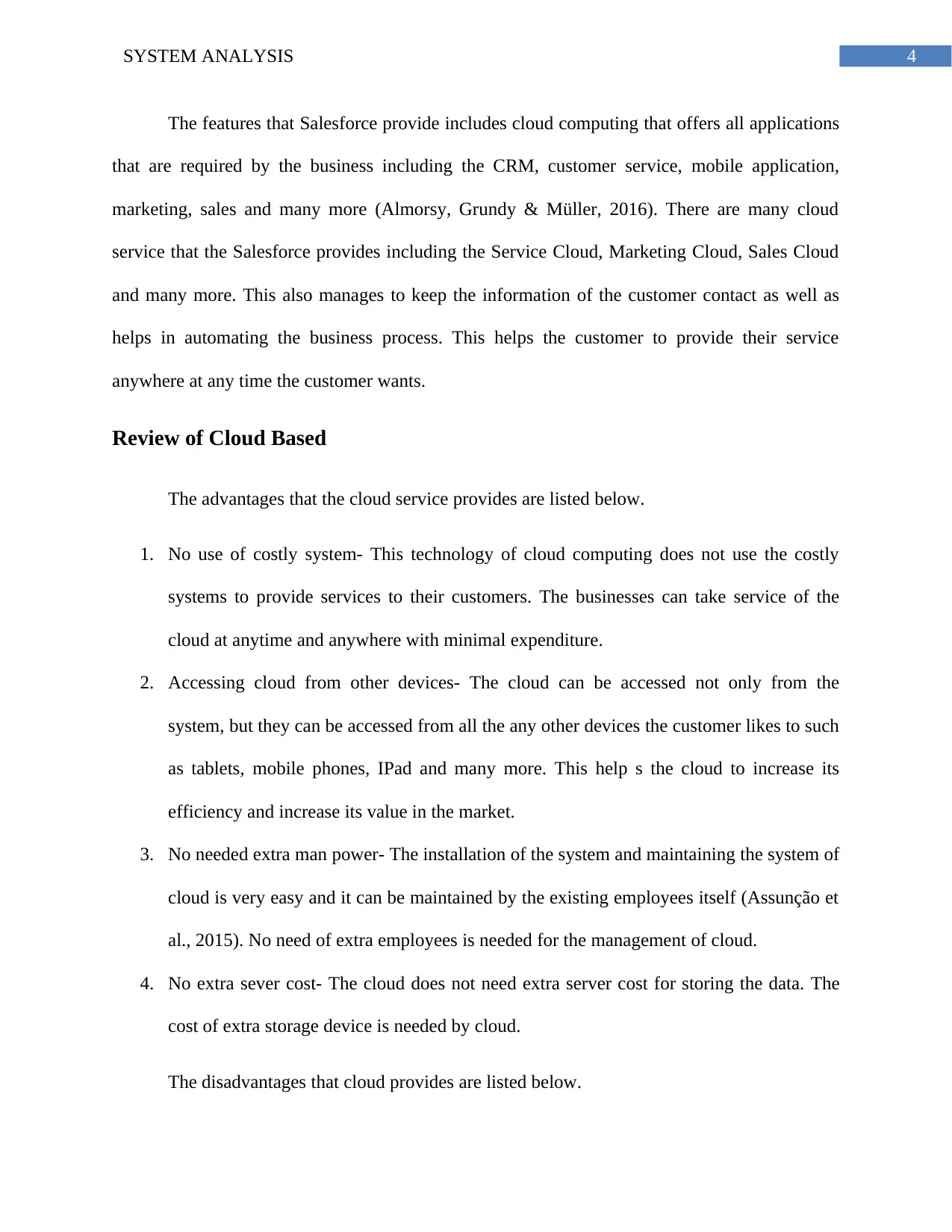
4SYSTEM ANALYSIS
The features that Salesforce provide includes cloud computing that offers all applications
that are required by the business including the CRM, customer service, mobile application,
marketing, sales and many more (Almorsy, Grundy & Müller, 2016). There are many cloud
service that the Salesforce provides including the Service Cloud, Marketing Cloud, Sales Cloud
and many more. This also manages to keep the information of the customer contact as well as
helps in automating the business process. This helps the customer to provide their service
anywhere at any time the customer wants.
Review of Cloud Based
The advantages that the cloud service provides are listed below.
1. No use of costly system- This technology of cloud computing does not use the costly
systems to provide services to their customers. The businesses can take service of the
cloud at anytime and anywhere with minimal expenditure.
2. Accessing cloud from other devices- The cloud can be accessed not only from the
system, but they can be accessed from all the any other devices the customer likes to such
as tablets, mobile phones, IPad and many more. This help s the cloud to increase its
efficiency and increase its value in the market.
3. No needed extra man power- The installation of the system and maintaining the system of
cloud is very easy and it can be maintained by the existing employees itself (Assunção et
al., 2015). No need of extra employees is needed for the management of cloud.
4. No extra sever cost- The cloud does not need extra server cost for storing the data. The
cost of extra storage device is needed by cloud.
The disadvantages that cloud provides are listed below.
The features that Salesforce provide includes cloud computing that offers all applications
that are required by the business including the CRM, customer service, mobile application,
marketing, sales and many more (Almorsy, Grundy & Müller, 2016). There are many cloud
service that the Salesforce provides including the Service Cloud, Marketing Cloud, Sales Cloud
and many more. This also manages to keep the information of the customer contact as well as
helps in automating the business process. This helps the customer to provide their service
anywhere at any time the customer wants.
Review of Cloud Based
The advantages that the cloud service provides are listed below.
1. No use of costly system- This technology of cloud computing does not use the costly
systems to provide services to their customers. The businesses can take service of the
cloud at anytime and anywhere with minimal expenditure.
2. Accessing cloud from other devices- The cloud can be accessed not only from the
system, but they can be accessed from all the any other devices the customer likes to such
as tablets, mobile phones, IPad and many more. This help s the cloud to increase its
efficiency and increase its value in the market.
3. No needed extra man power- The installation of the system and maintaining the system of
cloud is very easy and it can be maintained by the existing employees itself (Assunção et
al., 2015). No need of extra employees is needed for the management of cloud.
4. No extra sever cost- The cloud does not need extra server cost for storing the data. The
cost of extra storage device is needed by cloud.
The disadvantages that cloud provides are listed below.
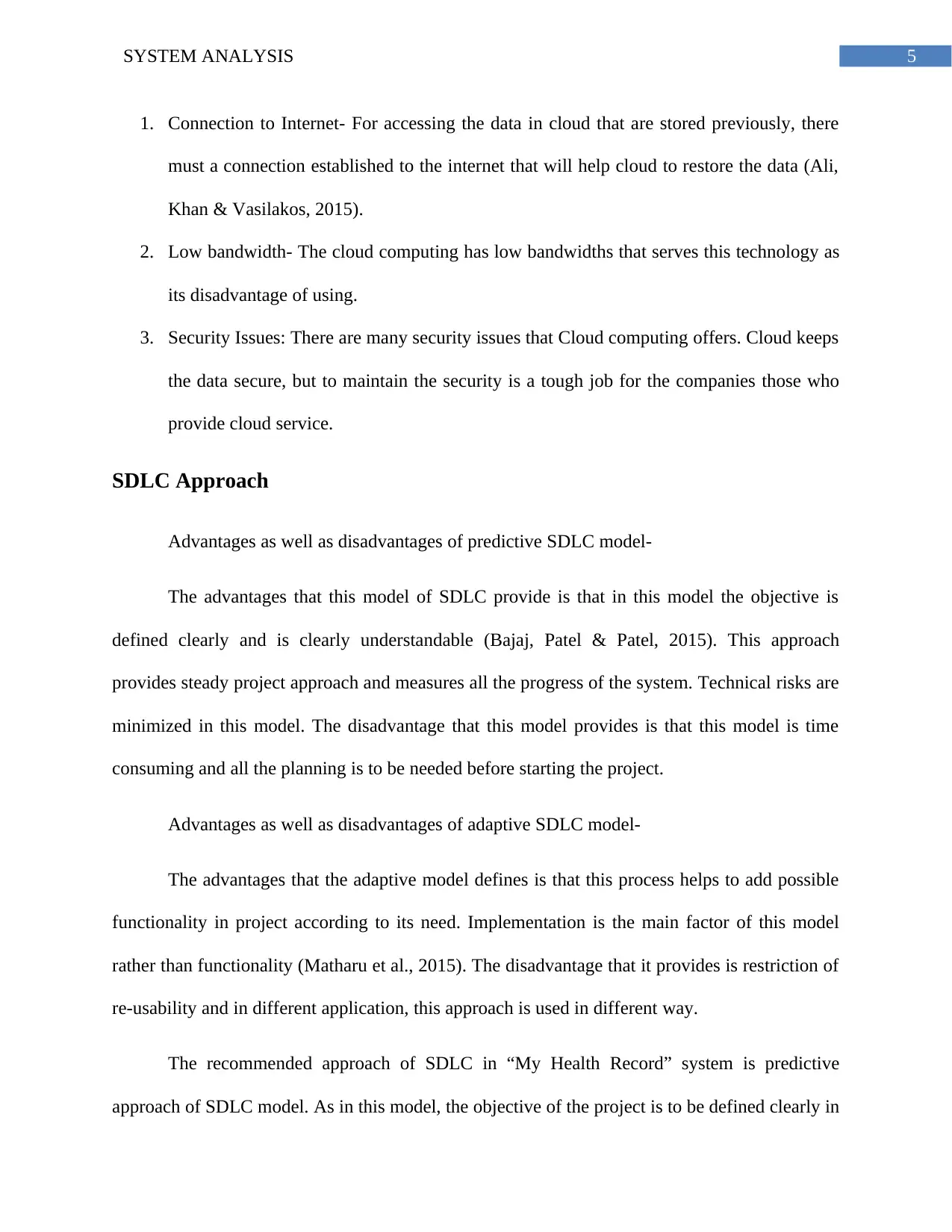
5SYSTEM ANALYSIS
1. Connection to Internet- For accessing the data in cloud that are stored previously, there
must a connection established to the internet that will help cloud to restore the data (Ali,
Khan & Vasilakos, 2015).
2. Low bandwidth- The cloud computing has low bandwidths that serves this technology as
its disadvantage of using.
3. Security Issues: There are many security issues that Cloud computing offers. Cloud keeps
the data secure, but to maintain the security is a tough job for the companies those who
provide cloud service.
SDLC Approach
Advantages as well as disadvantages of predictive SDLC model-
The advantages that this model of SDLC provide is that in this model the objective is
defined clearly and is clearly understandable (Bajaj, Patel & Patel, 2015). This approach
provides steady project approach and measures all the progress of the system. Technical risks are
minimized in this model. The disadvantage that this model provides is that this model is time
consuming and all the planning is to be needed before starting the project.
Advantages as well as disadvantages of adaptive SDLC model-
The advantages that the adaptive model defines is that this process helps to add possible
functionality in project according to its need. Implementation is the main factor of this model
rather than functionality (Matharu et al., 2015). The disadvantage that it provides is restriction of
re-usability and in different application, this approach is used in different way.
The recommended approach of SDLC in “My Health Record” system is predictive
approach of SDLC model. As in this model, the objective of the project is to be defined clearly in
1. Connection to Internet- For accessing the data in cloud that are stored previously, there
must a connection established to the internet that will help cloud to restore the data (Ali,
Khan & Vasilakos, 2015).
2. Low bandwidth- The cloud computing has low bandwidths that serves this technology as
its disadvantage of using.
3. Security Issues: There are many security issues that Cloud computing offers. Cloud keeps
the data secure, but to maintain the security is a tough job for the companies those who
provide cloud service.
SDLC Approach
Advantages as well as disadvantages of predictive SDLC model-
The advantages that this model of SDLC provide is that in this model the objective is
defined clearly and is clearly understandable (Bajaj, Patel & Patel, 2015). This approach
provides steady project approach and measures all the progress of the system. Technical risks are
minimized in this model. The disadvantage that this model provides is that this model is time
consuming and all the planning is to be needed before starting the project.
Advantages as well as disadvantages of adaptive SDLC model-
The advantages that the adaptive model defines is that this process helps to add possible
functionality in project according to its need. Implementation is the main factor of this model
rather than functionality (Matharu et al., 2015). The disadvantage that it provides is restriction of
re-usability and in different application, this approach is used in different way.
The recommended approach of SDLC in “My Health Record” system is predictive
approach of SDLC model. As in this model, the objective of the project is to be defined clearly in
⊘ This is a preview!⊘
Do you want full access?
Subscribe today to unlock all pages.

Trusted by 1+ million students worldwide
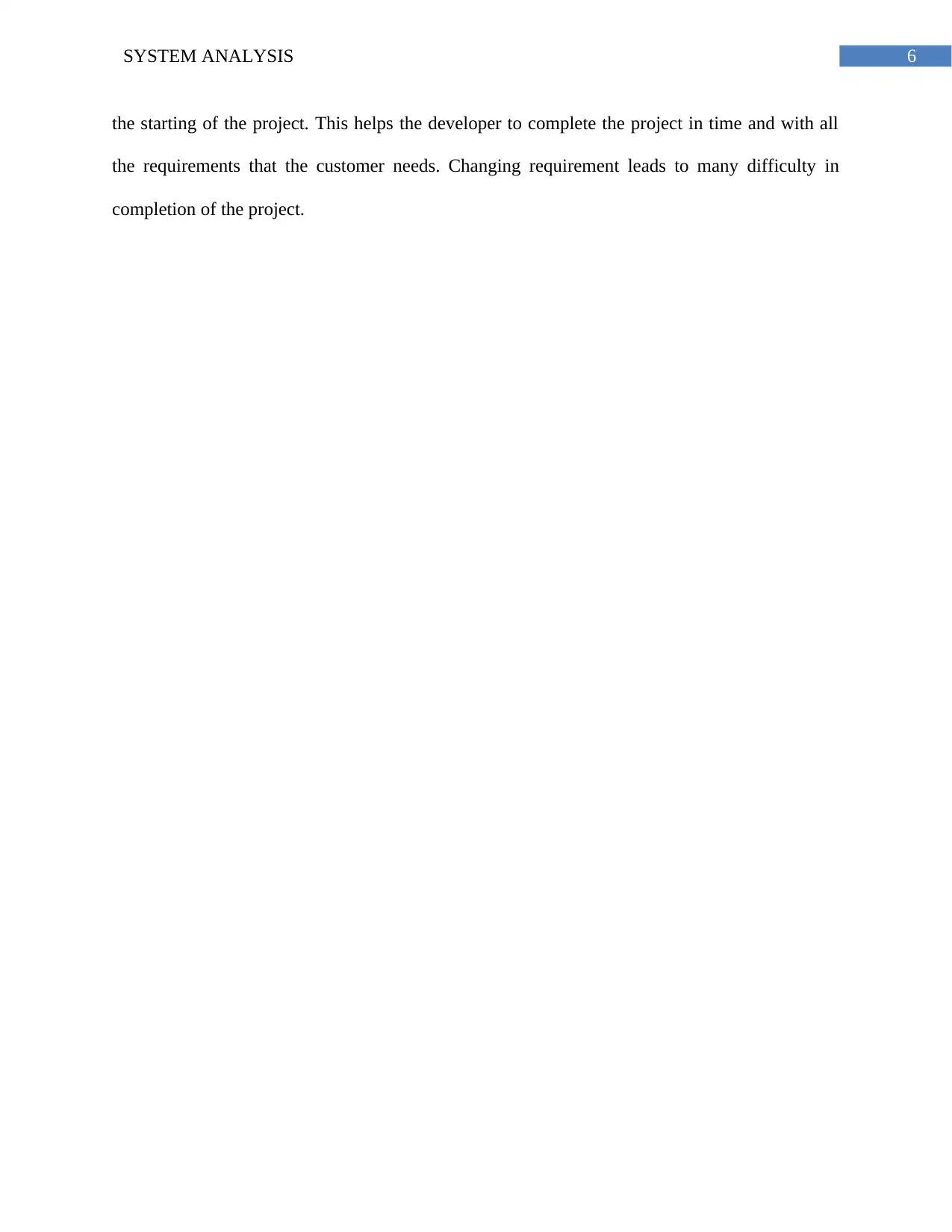
6SYSTEM ANALYSIS
the starting of the project. This helps the developer to complete the project in time and with all
the requirements that the customer needs. Changing requirement leads to many difficulty in
completion of the project.
the starting of the project. This helps the developer to complete the project in time and with all
the requirements that the customer needs. Changing requirement leads to many difficulty in
completion of the project.
Paraphrase This Document
Need a fresh take? Get an instant paraphrase of this document with our AI Paraphraser
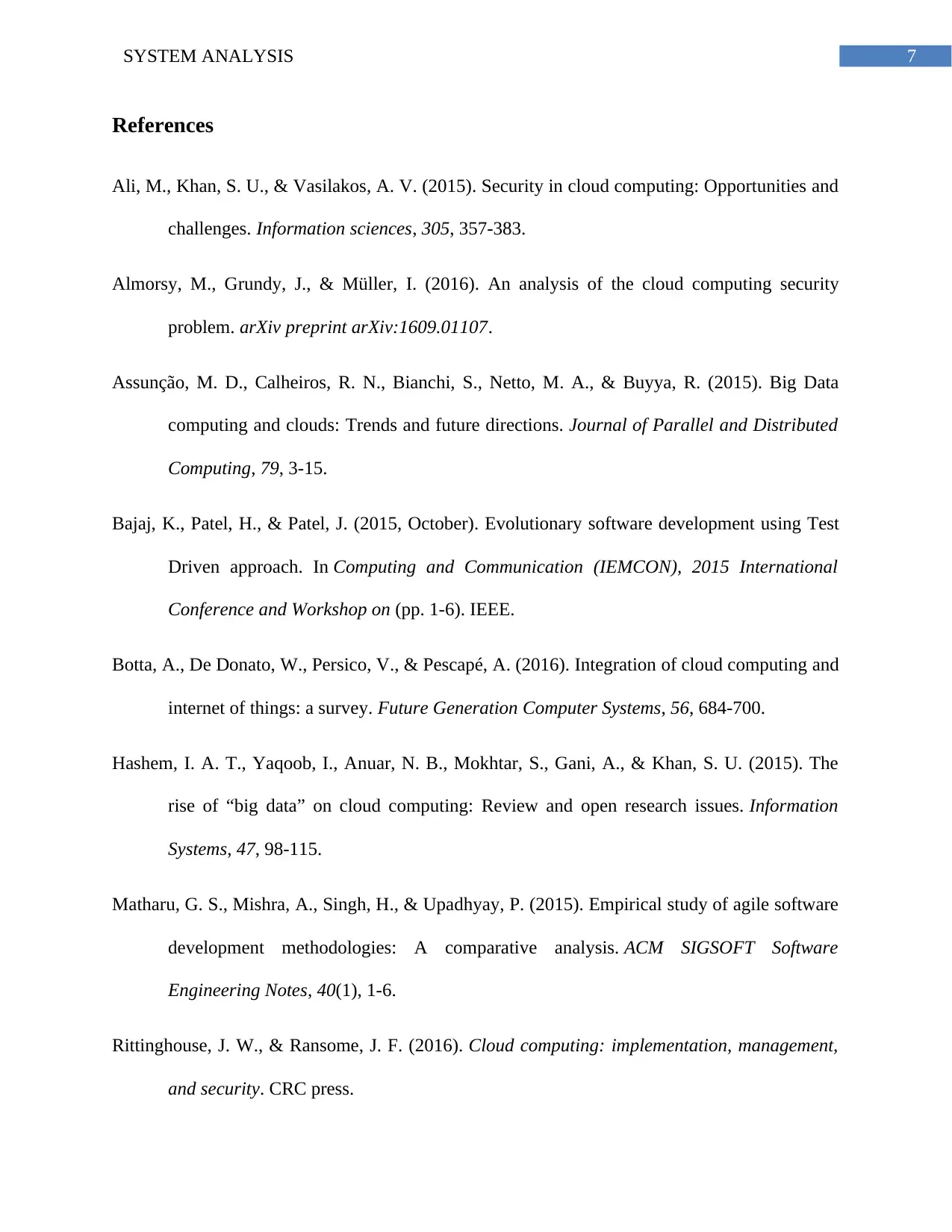
7SYSTEM ANALYSIS
References
Ali, M., Khan, S. U., & Vasilakos, A. V. (2015). Security in cloud computing: Opportunities and
challenges. Information sciences, 305, 357-383.
Almorsy, M., Grundy, J., & Müller, I. (2016). An analysis of the cloud computing security
problem. arXiv preprint arXiv:1609.01107.
Assunção, M. D., Calheiros, R. N., Bianchi, S., Netto, M. A., & Buyya, R. (2015). Big Data
computing and clouds: Trends and future directions. Journal of Parallel and Distributed
Computing, 79, 3-15.
Bajaj, K., Patel, H., & Patel, J. (2015, October). Evolutionary software development using Test
Driven approach. In Computing and Communication (IEMCON), 2015 International
Conference and Workshop on (pp. 1-6). IEEE.
Botta, A., De Donato, W., Persico, V., & Pescapé, A. (2016). Integration of cloud computing and
internet of things: a survey. Future Generation Computer Systems, 56, 684-700.
Hashem, I. A. T., Yaqoob, I., Anuar, N. B., Mokhtar, S., Gani, A., & Khan, S. U. (2015). The
rise of “big data” on cloud computing: Review and open research issues. Information
Systems, 47, 98-115.
Matharu, G. S., Mishra, A., Singh, H., & Upadhyay, P. (2015). Empirical study of agile software
development methodologies: A comparative analysis. ACM SIGSOFT Software
Engineering Notes, 40(1), 1-6.
Rittinghouse, J. W., & Ransome, J. F. (2016). Cloud computing: implementation, management,
and security. CRC press.
References
Ali, M., Khan, S. U., & Vasilakos, A. V. (2015). Security in cloud computing: Opportunities and
challenges. Information sciences, 305, 357-383.
Almorsy, M., Grundy, J., & Müller, I. (2016). An analysis of the cloud computing security
problem. arXiv preprint arXiv:1609.01107.
Assunção, M. D., Calheiros, R. N., Bianchi, S., Netto, M. A., & Buyya, R. (2015). Big Data
computing and clouds: Trends and future directions. Journal of Parallel and Distributed
Computing, 79, 3-15.
Bajaj, K., Patel, H., & Patel, J. (2015, October). Evolutionary software development using Test
Driven approach. In Computing and Communication (IEMCON), 2015 International
Conference and Workshop on (pp. 1-6). IEEE.
Botta, A., De Donato, W., Persico, V., & Pescapé, A. (2016). Integration of cloud computing and
internet of things: a survey. Future Generation Computer Systems, 56, 684-700.
Hashem, I. A. T., Yaqoob, I., Anuar, N. B., Mokhtar, S., Gani, A., & Khan, S. U. (2015). The
rise of “big data” on cloud computing: Review and open research issues. Information
Systems, 47, 98-115.
Matharu, G. S., Mishra, A., Singh, H., & Upadhyay, P. (2015). Empirical study of agile software
development methodologies: A comparative analysis. ACM SIGSOFT Software
Engineering Notes, 40(1), 1-6.
Rittinghouse, J. W., & Ransome, J. F. (2016). Cloud computing: implementation, management,
and security. CRC press.
1 out of 8
Related Documents
Your All-in-One AI-Powered Toolkit for Academic Success.
+13062052269
info@desklib.com
Available 24*7 on WhatsApp / Email
![[object Object]](/_next/static/media/star-bottom.7253800d.svg)
Unlock your academic potential
Copyright © 2020–2025 A2Z Services. All Rights Reserved. Developed and managed by ZUCOL.




